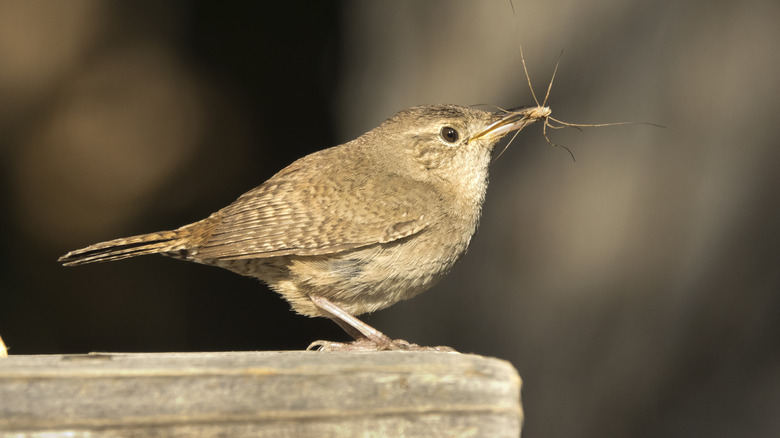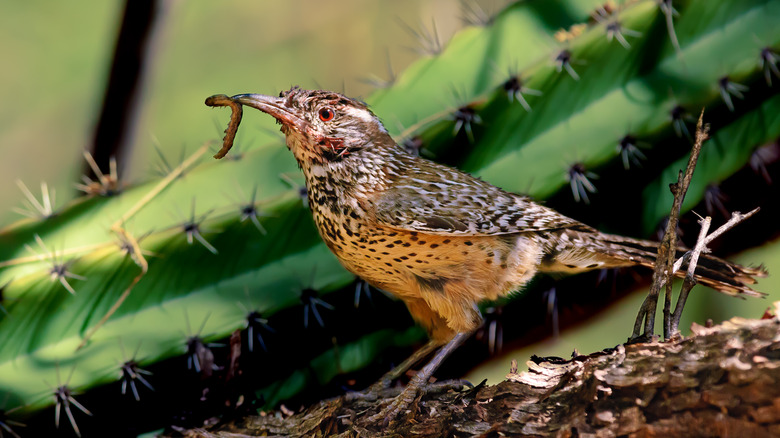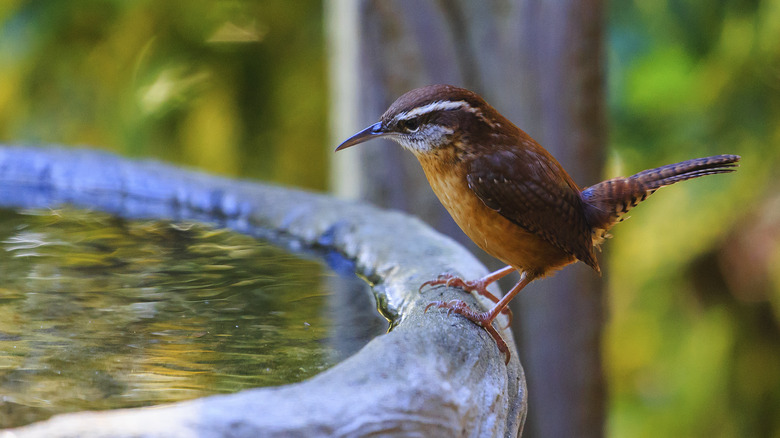Here's The Secret To Attracting Wrens To Your Yard
Forget about hiring an expensive exterminator to rid your property of pesky insects. Instead, turn to a tiny, fine-billed, winged hero who will fly to your yard for free to help mitigate your bug problem. Let's hear it for the backyard wren. Known for its dumpy build and scintillating voice, the familiar garden bird is also recognized for its ability to transform into a veritable insect vacuum, and it works for cheap. All you have to do to attract wrens to your yard is to provide full access to a robust bug buffet, water, and a safe place to nest.
As a budget-conscious homeowner, you'd be hard-pressed to find a more cost-effective and eco-friendly way to keep bugs out of your garden than a wren. The high-octane songbird sustains itself on a diet of creepy crawlies, from flies and ants to grasshoppers and beetles. The feisty birds will stop at nothing to ensure a good meal, going as far as prying live spiders from their webs before exalting their conquests with a distinctive bold and brassy call. Fortunately, the key to maximizing the benefits of befriending these pint-sized pipers is simply to make your yard as hospitable to them as possible. What's more, by fine-tuning these measures you can ensure wrens aren't just fly-by-night visitors, but rather, regular members of your family.
Wrens love insects
They may be small in stature — weighing roughly the same as two quarters — however, wrens have mighty appetites with a cornucopia of insects topping their favorite foods list. To attract wrens to your garden, avoid using insecticides or other commercial bug killers. Doing so will not only guarantee wrens enjoy a smorgasbord of critters, but also the bugs they consume won't be tainted with toxins. Providing a healthy and abundant food source will go a long way to sustain the well-being of your backyard wren population.
In addition, you can further increase insect variety and numbers by keeping brush piles intact. Fallen leaves, tall grass, and shrub debris create the ideal environment for wrens to forage for snails and slugs. Moreover, foliage fragments provide wrens with strategic covering. Having this level of protection decreases their anxiety level and allows them to comfortably scavenge for the perfect snack.
If, however, you want to supplement these natural feeding spots, the best type of bird feeder to add to your backyard is one that features a shallow dish or tray. This provides wrens with easy access to one of their very favorite treats: mealworms. You'll likely see a surge in wren activity if you also stock your feeder with crickets, suet, or peanut butter. During the winter months, wrens can be easily wooed to your garden by adding berry shrubs to your landscape.
Lure wrens to your yard with water and shelter
Eating all those bugs makes wrens incredibly thirsty, which is why placing water features on your property will entice the curious songbirds to put down roots. Birdbaths and fountains with moving water or splash features are particularly attractive to inquisitive wrens. If you opt to install a birdbath, pedestal and ground models will catch a wren's eye. However, given their petite legs, aim to fill the water source with only about an inch of liquid as wrens will shy away from anything deeper.
To draw in a steady stream of wrens to your property, pair your water feature with a shelter. The songbirds' compact size makes them especially vulnerable to predators, so providing them with dense landscaping as protection will sway them to stay for long periods of time. Tall trees and thick bushes located in close proximity to water sources create the ideal home for migrating wrens.
Finally, if you are not the most conscientious gardener, wrens will be the last to pile on the shame. In fact, the pint-sized crooners are infinitely more attracted to yards that are a little cluttered and unkempt than those that are open and pristine. Low-hanging branches, stray twigs, overgrown moss, and tall grass are a wren's dream nest-building materials. While it may seem counterintuitive, your lack of yard upkeep is the secret to engineering a sanctuary for the minuscule birds.


